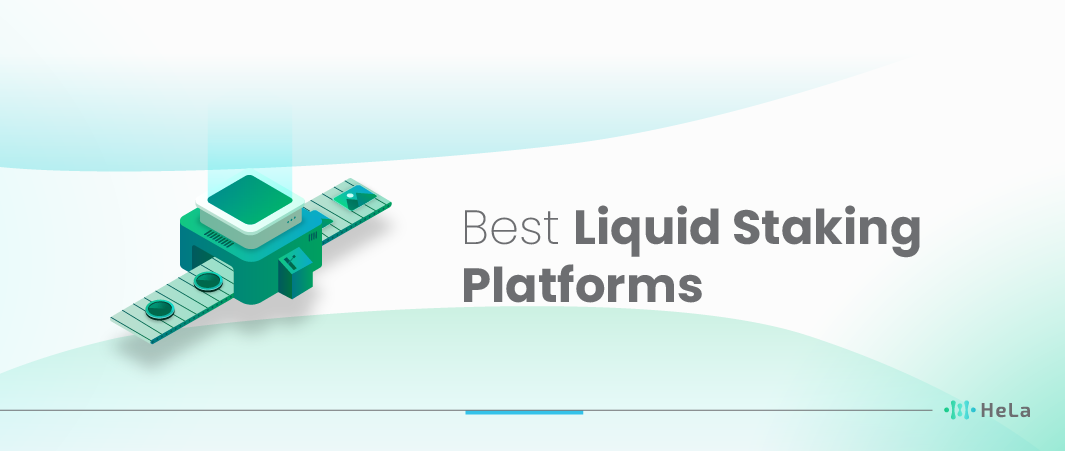Liquid staking, a transformative concept in the cryptocurrency sphere, enables crypto enthusiasts to stake assets while retaining their liquidity, a notable advancement from traditional staking methods. This approach not only secures investments but also offers rewards, aligning with the decentralized finance (DeFi) trend that seeks financial opportunities outside conventional banking. As DeFi grows, liquid staking platforms, simplifying asset staking and reward access, become integral to this evolving ecosystem, offering a dynamic participation mode in the staking economy.
Our guide lists the top 15 liquid staking platforms, selected based on security, user experience, rewards, and community trust. These platforms offer an optimized staking experience, catering to various user needs, from seasoned investors to beginners. Each platform ensures asset security and maximizes earnings potential, aiding users in confidently exploring the vibrant world of liquid staking.
Understanding Liquid Staking
Liquid staking is a concept that has gained significant attention and popularity in the cryptocurrency space, particularly in the context of proof-of-stake (PoS) blockchain networks. It represents a novel approach to staking, offering several advantages over traditional staking methods. To better understand liquid staking, let’s delve into how it works, its benefits, and why it’s becoming increasingly favored among crypto enthusiasts.
How Liquid Staking Works
- Staking in PoS Networks: In PoS blockchain networks, validators are chosen to create new blocks and validate transactions based on the amount of cryptocurrency they “stake” as collateral. The more cryptocurrency you lock up as a validator, the higher the chance you have of being selected to validate transactions and earn rewards.
- Illiquidity Challenge: Traditional staking involves locking up your assets for a specific period, which can range from days to months or even years. During this period, your tokens are illiquid and cannot be freely traded or used for other purposes. This can be a significant drawback, especially in volatile markets or when you want to take advantage of other investment opportunities.
- Liquid Staking Solution: Liquid staking addresses the illiquidity issue by allowing token holders to stake their assets while still retaining the ability to trade or utilize them. Essentially, it “tokenizes” the staked assets, creating a representation of the staked tokens that can be freely traded and transferred on secondary markets.
- Staked Tokens as Liquidity: These tokenized staked assets, often referred to as “liquid staking tokens” or “staking derivatives,” can be traded on decentralized exchanges (DEXs) or used as collateral in lending platforms. They mirror the value of the original staked tokens, and the staker continues to earn staking rewards on them.
Benefits of Liquid Staking
- Liquidity: The primary advantage of liquid staking is liquidity. Token holders can stake their assets to earn rewards while maintaining the flexibility to trade or utilize them as needed. This allows for a more dynamic and efficient use of capital.
- Risk Diversification: Liquid staking allows users to hedge their risk by staking assets while also having the ability to react to market conditions or quickly exit their positions if necessary.
- Access to DeFi: Staked tokens can be used as collateral in decentralized finance (DeFi) applications, unlocking additional opportunities for yield generation and lending.
- Increased Participation: Liquid staking can encourage greater participation in PoS networks by reducing the barriers to entry. Users who may have been hesitant to lock up their assets for an extended period are more likely to engage in staking when they can maintain liquidity.
Popularity Among Crypto Enthusiasts
The growing popularity of liquid staking can be attributed to several factors:
- Flexibility: Crypto enthusiasts appreciate the flexibility liquid staking offers, allowing them to actively manage their assets while still earning rewards.
- DeFi Integration: As the DeFi ecosystem expands, the ability to use staked assets as collateral in lending and yield farming has become increasingly attractive.
- Reduced Opportunity Cost: Liquid staking minimizes the opportunity cost associated with locking up assets, which is crucial in fast-moving cryptocurrency markets.
- Enhanced Network Security: Liquid staking can lead to increased participation in PoS networks, thereby enhancing network security by encouraging more validators and nodes.
Liquid staking represents a promising evolution in the staking ecosystem, providing token holders with the best of both worlds: the ability to earn rewards through staking while maintaining liquidity and flexibility. Its benefits over traditional staking methods and its alignment with the broader trends in the cryptocurrency space have made it a compelling choice for many crypto enthusiasts and investors.
Also Read: What Is Consensus Mechanism? Relevance in Blockchain and Cryptocurrency Explained
The Importance of Choosing the Right Platform

Choosing the right liquid staking platform is crucial for individuals and organizations looking to participate in staking activities within the cryptocurrency ecosystem. Staking involves locking up a certain amount of cryptocurrency in a network’s wallet to support network operations, and in return, participants receive rewards. Here are some factors that make a liquid staking platform reliable and trustworthy:
Security Measures
- Cold Storage: A reputable platform should use cold storage solutions to protect users’ assets. Cold storage involves storing a significant portion of the staked assets offline, making it less vulnerable to online threats like hacking.
- Multi-Signature Wallets: Multi-signature wallets require multiple keys to authorize transactions, adding an extra layer of security to the platform.
- Insurance: Some platforms offer insurance coverage for user funds in case of unexpected events or security breaches.
Transparency
- Open Source Code: Platforms that provide open-source code for their smart contracts and staking mechanisms enable users to review and audit the code for vulnerabilities or hidden risks.
- Regular Audits: Regular security audits by reputable third-party firms can help build trust by ensuring that the platform’s code and operations are secure and reliable.
- Publicly Accessible Data: The platform should provide transparent and real-time data about staking rewards, token holdings, and other relevant information for users to verify.
User Support
- Responsive Customer Service: A reliable platform should have a responsive customer support team available to assist users with inquiries, issues, or technical problems.
- Educational Resources: Providing educational materials and guides for users, especially those new to staking, demonstrates a commitment to user support and engagement.
Variety of Staking Options
- Token Selection: A good liquid staking platform should support a variety of tokens and cryptocurrencies, allowing users to stake the assets they are most comfortable with.
- Staking Periods: Offering flexible staking periods allows users to choose the duration that best suits their investment strategy, whether short-term or long-term.
- Compounding Options: Some platforms offer options for compounding rewards automatically, helping users maximize their earnings over time.
Reputation and Track Record
- History of Operations: Research the platform’s history, including any past security incidents or issues. A solid track record of secure operations and consistent rewards is a positive sign.
- Community Feedback: User reviews and feedback can provide valuable insights into the platform’s reliability and performance.
Regulatory Compliance
- Ensure that the platform complies with relevant financial regulations and adheres to Know Your Customer (KYC) and Anti-Money Laundering (AML) requirements, as this can help protect users and maintain trust in the platform.
Governance and Upgrades
- Platforms that involve their community in governance decisions and regularly update their protocol to adapt to changing market conditions are more likely to be responsive and adaptable.
15 Best Liquid Staking Platforms to Consider in 2024

As of 2024, the landscape of liquid staking platforms has grown significantly, offering a variety of options for cryptocurrency staking. Here’s an overview of the top 15 liquid staking platforms, highlighting their key features and supported cryptocurrencies:
1. Lido Finance
Lido is the largest liquid staking platform with over $14 billion TVL, supporting Ethereum, Polygon, and Solana. It offers APYs between 4.4% and 6.7% with daily payouts, without a minimum staking amount. Lido charges a 10% fee and allows users to use stETH and stSOL on various DeFi platforms. However, its dominance raises questions about decentralization and it has higher fees compared to others.
2. Coinbase Prime
This platform, with over $2 billion TVL, is ideal for both beginners and institutional investors, focusing on Ethereum. Coinbase offers a 2% – 6.12% APY with no staking period and a minimum staking amount of 0.1ETH. The platform charges a 15% fee on staking rewards and allows users to cash rewards daily or quarterly. Its easy-to-use interface is a major plus, although it offers fewer tokens for staking compared to other platforms.
3. Rocket Pool
With a community-driven approach and over $1.8 billion TVL, Rocket Pool supports Ethereum and offers 3.93% rewards. The platform allows staking as low as 0.01ETH, charges 5% – 20% fees, and offers no staking period limit. It’s decentralized, allowing individuals and businesses to set up staking pools, but has a lock-in period for validators and can charge up to 20% on rewards.
4. Frax Ether
Frax Ether, part of the Frax Finance ecosystem, has over $400 million TVL and supports Ethereum. It offers a 5.22% yield, with users receiving frxETH tokens for staking ETH. The platform is decentralized and run by the community of Frax holders. However, it faces market risks and regulatory issues, and its platform functionality might be complicated for beginners.
5. Stake Wise
Launched in 2021, Stake Wise is an open-source Ethereum staking application with around $170 million TVL. It allows users to stake any amount of ETH and receive sETH2 tokens, which can be used with other dApps on the Ethereum blockchain. The platform has been successful in accumulating over 50,000 ETH in deposits and offers a user-friendly interface.
6. Marinade Finance
Built on the Solana blockchain, Marinade Finance was launched in 2021 and provides a way for users to earn yield on their SOL tokens. In exchange for staking, users receive mSOL tokens, which represent their stake and increase in value with staking rewards. The platform is governed by a DAO using the MNDE token and supports over 450 validators, enhancing network security.
7. JPool
Based in Switzerland, JPool allows users to stake SOL tokens on the Solana network. Users receive JSOL tokens, representing ownership in the pool, which accrue staking rewards. JSOL can be used as a DeFi instrument for liquidity mining, with rewards up to 6.5-8% annually. The platform strengthens network decentralization by distributing SOL tokens staked among all validators.
8. Stader
Stader is a multi-chain liquid staking solution with over 85,000 users and $124 million in staked assets. It supports various networks like Ethereum, Polygon, Hedera, BNB, Fantom, Near, Terra 2.0, offering flexible staking options. Stader offers liquid equivalents of staked tokens, which are usable in over 40 DeFi protocols, allowing additional rewards and maintaining liquidity.
9. Sanitatis Staking
This platform prioritizes security and employs low-risk trading tactics like arbitrage, minimizing risk while generating consistent returns. It offers a user-friendly interface, allowing investors to easily access and track their earnings and withdraw rewards at any time.
10. Tenderize
Founded in December 2021, Tenderize enables users to stake cryptocurrencies like MATIC, GRT, LPT, and AUDIO, receiving tenderTokens in return. These tokens represent a 1:1 derivative of the underlying deposit and can be freely traded. The platform allows earning compounding staking rewards and liquidity farming rewards.
11. Keep Network
Launched in 2017, Keep Network provides secure storage for private data on public blockchains and operates a liquid staking application. Users can stake native Bitcoin tokens and receive tBTC tokens on the Ethereum network, earning staking rewards and accessing the Ethereum network.
12. Binance
Binance is a global cryptocurrency exchange that offers liquid staking services. It stands out for its extensive user base and reputation in the crypto space. Binance’s liquid staking option is part of its comprehensive suite of crypto services, including trading, lending, and more. The platform is known for its security measures and user-friendly interface, making it accessible for both beginners and experienced traders. Binance supports a variety of cryptocurrencies, providing users with a diverse range of staking options.
13. Ankr
Ankr is a decentralized staking service that offers a wide range of supported networks, making it a versatile choice for users. It’s known for its commitment to decentralization and providing accessible staking solutions to a global audience. Ankr’s platform enables users to participate in blockchain ecosystems by offering easy-to-use staking services. The platform places a strong emphasis on user experience and security, aiming to make staking straightforward and safe. Ankr is a popular choice for users looking to diversify their staking across multiple blockchain networks.
14. EigenLayer
EigenLayer focuses on enhancing the scalability and security of blockchain networks through its staking services. The platform is designed to support large-scale and high-frequency blockchain operations, making it suitable for enterprise-level applications. EigenLayer’s unique approach to staking involves leveraging the existing security of Ethereum to create new layers of decentralized networks. This method allows users to participate in securing multiple networks without compromising on the safety and integrity of their staked assets. EigenLayer is a pioneering choice for those interested in supporting next-generation blockchain infrastructures.
15. Stader Labs
Stader Labs offers a user-friendly interface that simplifies the staking process, making it accessible for a wide range of users. The platform provides staking services across multiple blockchains, allowing users to diversify their staking portfolio. Stader Labs emphasizes security and transparency, ensuring users have a clear understanding of the staking process and the safety of their assets. The platform’s design caters to both novice and experienced users, offering detailed analytics and easy access to staking rewards. Stader Labs is recognized for its commitment to enhancing the staking experience while maintaining high standards of security and user support.
Each of these platforms has its own unique selling points, such as support for different cryptocurrencies, yield percentages, and additional features like decentralized governance or integration with DeFi protocols. When choosing a liquid staking platform, it’s important to consider factors such as supported assets, security protocols, ease of use, and fee structures.
Also Read: The Top 5 Layer 1 Cryptocurrencies You Can’t Afford to Ignore!
Maximizing Your Staking Rewards

Maximizing your staking rewards through liquid staking involves a combination of strategic planning and staying informed. Here are some tips and strategies to help you achieve this:
- Understand the Reward Structures: Before you start, it’s crucial to understand how the staking rewards are structured in the platform or protocol you choose. Different platforms may have varying reward mechanisms, including fixed or variable rates, and bonuses for long-term staking. Familiarize yourself with these details to make informed decisions.
- Diversification: Just like with any investment, diversification is key in staking. Spread your investments across different staking pools, cryptocurrencies, or platforms. This approach helps mitigate risks associated with the volatility of a single asset or the failure of a single platform.
- Choose Reliable Platforms: Opt for platforms that have a strong reputation and a history of stability and security. Research their past performance, read reviews, and understand their security measures to ensure that your assets are safe.
- Stay Updated with Market Trends: The cryptocurrency market is highly dynamic, and staying updated with the latest trends and news is vital. Changes in the market can affect staking rewards and risks. Subscribe to newsletters, follow crypto news sites, and participate in community discussions.
- Reinvest Your Rewards: Consider reinvesting your staking rewards to compound your returns. This strategy can significantly increase your overall returns over time, especially in platforms that offer higher rewards for larger and longer-term stakes.
- Understand the Risks: Be aware of the risks involved in staking, such as the volatility of crypto markets, potential regulatory changes, and the liquidity risk in some staking models. Ensure that you’re comfortable with these risks before investing.
- Consider Liquidity Needs: While staking, consider your liquidity needs. Some staking platforms may require your assets to be locked for a certain period, which could be an issue if you need immediate access to your funds. Liquid staking solutions offer more flexibility, allowing you to trade staked assets.
- Monitor Performance and Adjust Strategy: Regularly monitor the performance of your staked assets. Be prepared to adjust your strategy if the market conditions change or if you find more lucrative staking opportunities.
- Use Automated Tools: Consider using automated tools or platforms that can help you optimize your staking strategy. These tools can provide valuable insights and automate certain processes, making your staking more efficient.
- Stay Informed About Technological Developments: The technology in the blockchain and cryptocurrency space is continually evolving. Keeping yourself informed about new staking protocols, technologies, and improvements can help you take advantage of emerging opportunities.
Conclusion
In conclusion, the article underscores the importance of selecting the right liquid staking platform, a decision that greatly affects both the staking experience and potential returns. It’s imperative for readers to understand that choosing an appropriate platform is a key factor in the success of cryptocurrency staking. Moreover, the dynamic nature of the cryptocurrency market demands that investors stay well-informed and up-to-date, adapting their strategies to the evolving landscape.
Looking to the future, liquid staking holds a promising potential to transform cryptocurrency investment strategies. Investors are encouraged to thoroughly explore the platforms discussed, aligning their choices with their personal investment goals. By conducting diligent research and making informed decisions, readers can effectively navigate the complexities of the cryptocurrency market, potentially leading to rewarding investment outcomes.
Disclaimer: The information provided by HeLa Labs in this article is intended for general informational purposes and does not reflect the company’s opinion. It is not intended as investment advice or recommendations. Readers are strongly advised to conduct their own thorough research and consult with a qualified financial advisor before making any financial decisions.

Hi, I'm Carina, and I've been captivated by the world of web3 for as long as I can remember. Ever since I first dipped my toes into this innovative technology, I've found myself drawn to exploring and understanding its infinite potential. The complexities of layer 1 solutions particularly intrigue me, as they form the foundation of decentralized networks and pave the way for a more transparent and efficient digital landscape.
-
Carina Caringalhttps://helalabs.com/blog/author/carina-caringal/
-
Carina Caringalhttps://helalabs.com/blog/author/carina-caringal/
-
Carina Caringalhttps://helalabs.com/blog/author/carina-caringal/
-
Carina Caringalhttps://helalabs.com/blog/author/carina-caringal/

